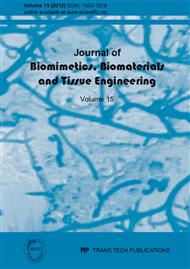[1]
K. Tao, D. M Wang, C. T Wang. Study on Biotribological Behaviour of the Combined Joint of CoCrMo and UHMWPE/BHA Composite in a Hip Joint Simulator. J. Bionic Eng. (2009), 6, 387-397.
DOI: 10.1016/s1672-6529(08)60139-0
Google Scholar
[2]
D. K Ramsey, P. F Wretenberg. Biomechanics of the knee: methodological considerations in the in vivo kinematic analysis of the tibiofemoral and patellofemoral joint. Clin Biomech. (1999), 14, 595-611.
DOI: 10.1016/s0268-0033(99)00015-7
Google Scholar
[3]
K. Deschamps, F. Staes, P. Roosen, F. Nobels, K. Desloovere, H. Bruyninckx, G. A Matricali. Body of evidence supporting the clinical use of 3D multisegment foot models: A systematic review. Gait & Posture (2011), 33 (3), 338-349.
DOI: 10.1016/j.gaitpost.2010.12.018
Google Scholar
[4]
C. Reinschmidt, A. J van den Bogert, A. Lundberg, B. M Nigg, N. Murphy, A. Stacoff, A. Stano. Tibiofemoral and tibiocalcaneal motion during walking: external vs. skeletal markers. Gait and Posture (1997), 6 (2), 98-109.
DOI: 10.1016/s0966-6362(97)01110-7
Google Scholar
[5]
C. Reinschmidt. Three-dimensional tibiocalcaneal and tibiofemoral kinematics during human locomotion – measured with external and bone marker [dissertation]. Calgary: The University of Calgary (1996).
Google Scholar
[6]
B. M Nigg, G. K Cole. In: Biomechanics of the musculo-skeletal system, Edited by B. M Nigg, W. Herzog, New York: Wiley (1994), 254-286.
Google Scholar
[7]
Z. Hu. Research of biomechanic characteristic of lower limbs motion in jogging [dissertation]. Beijing: Beijing Sport University (2008).
Google Scholar
[8]
Y. Song. The influence of different hardness sole to walking ability of human body [dissertation]. Shanghai: Shanghai University of Sport (2008).
Google Scholar
[9]
P. Caravaggi, A. Leardini, R. Crompton. Kinematic correlates of walking cadence in the foot. J. Biomech., (2010), 43 (12), 2425-2433.
DOI: 10.1016/j.jbiomech.2010.04.015
Google Scholar
[10]
M. B Pohl, N. Messenger, J. G Buckley. Changes in foot and lower limb coupling due to systematic variations in step width. Clin Biomech (2006), 21 (2), 175-183.
DOI: 10.1016/j.clinbiomech.2005.09.005
Google Scholar
[11]
M. B Pohl, N. Messenger, J. G Buckley. Forefoot, rearfoot and shank coupling: Effect of variations in speed and mode of gait. Gait & Posture (2007), 25 (2), 295-302.
DOI: 10.1016/j.gaitpost.2006.04.012
Google Scholar
[12]
K. Tulchin, M. S Orendurff, S. Adolfsen, L. Karol. The Effects of Walking Speed on Multisegment Foot Kinematics in Adults. J Appl Biomech. (2009), 25 (4), 377-386.
DOI: 10.1123/jab.25.4.377
Google Scholar


